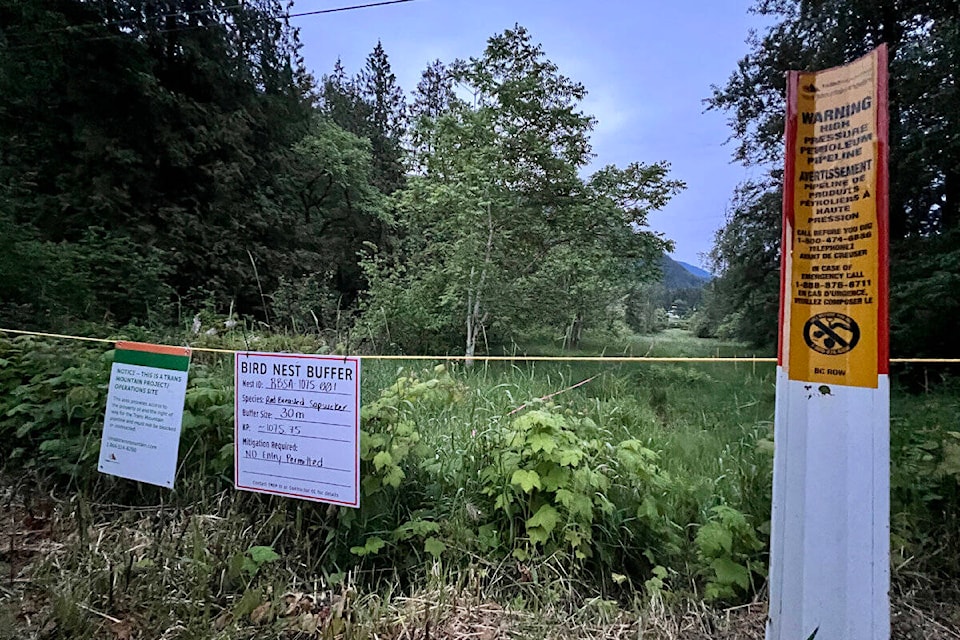Construction on the Trans Mountain Pipeline Expansion Project (TMX) has finally started in the Chilliwack area, but thanks to a couple of mating woodpeckers, it’s on hold at one location near Bridal Falls.
While TMX crews operate heavy-duty machinery like excavators, feller bunchers and delimbers to clear the land adjacent to the existing pipeline route, all that can be shut down – temporarily – by red-breasted sapsuckers, American robins, and Anna’s hummingbirds.
“Every time that Community Nest Finding Network has been onsite before (TMX crews) cut trees we have found nests. The point is that Trans Mountain is not finding the nests so they shouldn’t be allowed to cut trees in the height of nesting season.”
That’s Sara Ross from the Community Nest Finding Network (CNFN), a group that has spent most of it’s time back in 2021 in the Burnaby area finding nests, and stalling TMX work.
It started when activists in trees discovered Anna’s humminbird nests leading to work stoppages for more than three months last summer alongside the Brunette River Conservation Area.
READ MORE: Trans Mountain tree cutting can resume as stop-work order on pipeline route lifts
Most recently what was found near Bridal Falls was active red-breasted sapsucker nests in trees. Ross said the nest was obvious to see from the ground, and while she said they were the ones who notified TMX of the nest after the company’s qualified environmental professional found nothing, the company did not respond to a question regarding the thoroughness of its surveying for wildlife along the pipeline route.

“Throughout the course of these surveys near Bridal Falls, bird nests were identified, and appropriate buffers were established,” a TMX spokesperson said via email. “Construction activities are halted until nests have fledged or deemed inactive by a qualified environmental professional.”
The TMX project has protocols in place for migratory bird nest survey and they are guided by the Migratory Birds Convention Act (MBCA). This is nesting season, and one year ago in Burnaby, the company was shut down when an Environment and Climate Change Canada (ECCC) wildlife officer issued a verbal stop work order due to a contravention of the MBCA, “which contravention resulted in the destruction of a migratory bird nest.”
Before that in May, a tree faller working “near Agassiz” for TMX destroyed an American Robin’s nest and eggs despite the nest being identified and a 30-metre buffer in place.
Back to the present and the red-breasted sapsucker nest identified near Bridal Falls, the company insists they implement measures to protect nesting birds.
“Mitigation measures include the use of non-intrusive nest sweeps and the establishment of species-specific buffer zones around active nests to ensure our construction activities have the least impact possible on nesting birds,” the TMX spokesperson said. “If nesting activity is identified during the surveys, a protective buffer is installed.”
But Ross insists the company isn’t doing nearly enough. She said because the area is also home to the at-risk Coastal giant salamander, the company simply picks them up and moves them when they are found. As for the birds, Ross points to the law that states: “If there are migratory bird nests where you plan to work, activities that could disturb or destroy nests should be avoided, adapted, rescheduled or relocated.”
And since it’s nesting season, there are likely hundreds of active nests in the TMX area where logging is scheduled or has already taken place. All you have to do is look and you’ll find nests.
“Trans Mountain will try to deny that anything unusual happened here, but we have video and audio footage of their contractors first telling us they were going to cut, and then telling us that they had stopped work because they’d been alerted to the nests,” Ross said. “They were onsite to clearcut this forest, but we stopped them. This sapsucker mama stopped them with our help.”
Active construction on the TMX project began earlier this year in the Chilliwack stretch. The 1,150-kilometre pipeline carries bitumen and other oil products from Alberta to the port in Burnaby.
Through Chilliwack, the existing pipeline runs on a diagonal across the city, crossing Highway 1 near Rosedale, and as it crosses Sardis it runs through the Kinkora Golf Course, crosses Vedder Road on Tzeachten land, then runs through the back school yards of Vedder Middle School and Watson Elementary School. The pipeline cross the Vedder River east of the Great Blue Heron Nature Reserve and runs underneath the Browne Creek Wetlands before running through Yarrow and to Abbotsford.
Residents may have seen early construction work in Chilliwack, particularly at Kinkora and on a stretch of land west of Chilliwack River Road, in addition to surveying and staking all along the route.
READ MORE: Detailed pipeline route through Chilliwack approved by federal regulator
RELATED: OPINION w/ VIDEO: Work forges ahead on Trans Mountain pipeline expansion in Chilliwack
Do you have something to add to this story, or something else we should report on? Email:
editor@theprogress.com
Like us on Facebook and follow us on Twitter.
